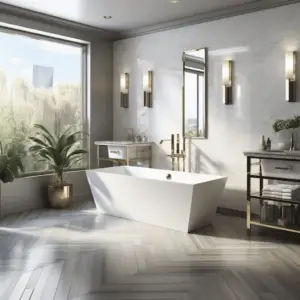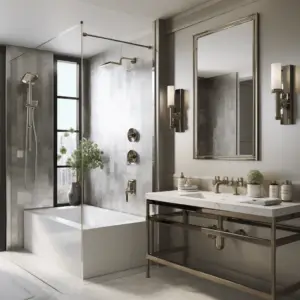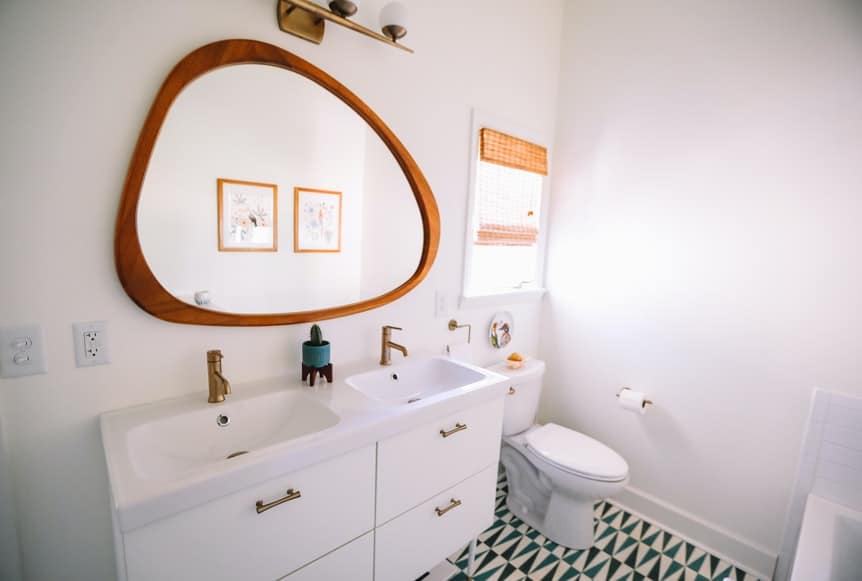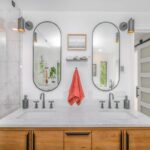There is no specific rule that makes it mandatory for you to mix metal finishes in the bathroom.
However, you need to consider the technique if you want to enhance the visual interest of your room.
It’s a trend that the modern bathrooms are styled with a high-impact mix of chrome and brushed nickel finishes.
Brushed nickel and chrome look alike, with the former pricier than the latter. The big dilemma is whether you can mix them. Mixing the metal finishes depends on your preference, especially if you want an even look.
So, is it right to mix chrome and brushed nickel in the bathroom? Yes, you can blend the metal finishes, although there is no particular rule that makes it a must. Therefore, if you want to improve the visual appeal of your bathroom, then mixing brushed nickel and chrome is a trendy style for modern bathrooms.
Table of Contents
Chrome vs. Brushed Nickel finishes in the bathroom

If you’re in the process of remodeling your bathroom or the kitchen, there is a higher chance that you will look for chrome or brushed nickel finishes for the faucets and cabinet handles.
Both chrome and brushed nickel are durable, affordable, and flexible to work on diverse styles.
When comparing brushed nickel versus chrome, you will note that brushed nickels have a dull and matte shine. Therefore, they are perfect when used for traditional kitchen designs.
Brushed nickel finishes hide dirt, water spots, and fingerprints. Nickel has the ideal properties that make it the suitable metal finish that you can have in your bathroom.
Compared to chrome, brushed nickel is slightly expensive because of the complex furnishing technique and the high-end appearance.
The basic brushed nickel goes for approximately $90, while the equivalent of chrome faucets costs $60.
Chrome finishes give your bathroom a shiny finish. Therefore, if you need light reflection to help you light up the room, then a chrome finish is the option. The shiny finish of chrome also gives the facets and other fixtures a clean feeling.
Contrary to the brushed nickel, chrome finishes show water spots, dirt, and fingerprints. The polished faucets, knobs, and pulls with chrome finish work well with the modern bathrooms and kitchens.
You need regular maintenance to keep the chrome fixtures in their shiny state.
Mixing Chrome and Brushed Nickel Finishes in Bathroom: Is it Possible?
When helping homeowners plan a bathroom makeover, one of the most often concerns is, “Can I mix Chrome and Brushed Nickel finishes, or do I have to keep to one?” The quick answer is that you can blend metal finishes in your bathroom.
However, when choosing several metals, there are certain guidelines to follow, such as how they complement each other, fit into the rest of your home’s design, and which textures you should choose to match the other materials in the space.
Mixing Chrome and Brushed Nickel Finishes in Bathroom: Some Tips
Here are the top six tips for mixing Chrome and Brushed Nickel finishes In the Bathroom. Follow the guide to help you make informed selections.
Tip #1: Complement rather than compete
In an interior design project, the objective is for all components in a room to work together to create a harmonious whole.
Design professionals advise utilizing no more than three metals when combining metals. This allows you to add visual appeal to the area without making it appear crowded.
Another thing to bear in mind when mixing chrome and brushed nickel finishes in a bathroom is that two metals from the same color family should not be mixed.
If you’re going with weathered brass, avoid bright gold because the two are similar in color but have different undertones and won’t look good together.
Two metals that closely match in one place might appear to be a mistake rather than a deliberate design choice.
When it comes to metal mixing, you want your selections to appear purposeful.
Tip #2: Begin with A Solid Foundation
About two-thirds of your bathroom’s fixtures should be made of the primary metal you choose.
Brushed nickel, polished chrome, or stainless steel for sink and bath faucets, knobs, showerheads, and grab bars are all great choices for modern or transitional aesthetics.
Choose a base metal with a “warm” undertone, like brass or bronze, if you want a classic or rustic look. Look for hammered copper, antique gold, matte black steel, brilliant nickel, and natural iron if you want a cutting-edge style.
Tip #3: Make a Statement with Your Accent
Choose a metal that compliments the tone of your base metal and overall bathroom style for the remaining third of your fixtures.
A nickel accent, for example, can enliven a classic bathroom, while matte black would emphasize a transitional space’s sophisticated side.
Choose finishes that are comparable in color, such as brushed nickel faucets with a matte brass mirror frame, to keep the aesthetic balanced.
You may use accent metal in various ways. Still, some popular choices include vanity hardware knobs and pulls, towel rings, lighting, mirror frames, shower trim, and accessories like soap dispensers and lamp bases.
Tip #4: Get Inspiration from Other Rooms
Take inspiration from other areas in your house when choosing tones for your major and accent metals.
Consider using polished chrome as the predominant metal in your bathroom if your kitchen faucet is in polished chrome.
If your hallways feature nickel light switch plates, you can choose nickel cabinet handles and sconces to convey the metal from one location to the next.
Tip #5: Coordination with other materials
Allow some of the other materials in the area to influence the metals you pick to reach your aim of building a well-balanced bathroom. For example, if you have a white wood vanity, stainless steel hardware can help give it a more contemporary look.
Brass knobs would complement the classic design of a classical vanity constructed of dark wood.
Tip #6: Texture Experimentation
When choosing metals for your bathroom, don’t forget about the texture. Modern metals can be brushed, burnished, antiqued, hand-rubbed, oiled, or hammered to offer a whole new depth to your fixtures, in addition to the traditional matte or polished surface options.
The satin finish on a set of brushed nickel faucet handles, for example, provides a cool, smooth tactile sensation.
On the other hand, water will flow in distinctive patterns toward the drain in a hammered bronze sink bowl.
The texture is a fantastic way to add a distinct sensory aspect to your bathroom, no matter how you choose to use it.
You should avoid selecting a single metal in a range of finishes; this seems more like a mistake than a deliberate design choice.
The Bottom Line
Combining metals has been going strong for a few years and shows no signs of dying off.
Design Consultants are ready to assist you whether you are eager to try your hand at Mixing Chrome and Brushed Nickel Finishes In Bathroom.
Refresh your bathroom with a different design trick and adhere to the design guidelines.
Brushed Nickel vs Chrome
The two metal finishes are trendy in our homes as they adapt to modern appliances and hardware in the bathroom, kitchen or rooms. Both are in silver tone; hence before deciding what you’ll use for your finish, it is noble to know how they differ.
Both metal finishes are durable, affordable, and flexible to work on diverse styles.
The two brushed nickel has a dull and matte shine making them ideal for conventional kitchen designs. It hides dirt, fingerprints, and water spots. Nickel contains properties that make it a perfect metal finish for your bathroom.
On the other hand, Chrome finish displays water spots, fingerprints, and dirt and thus requires regular maintenance to maintain the chrome fixtures in their original state. It offers your bathroom a shiny finish.
Chrome finish is suitable if you prefer lighting up your bathroom and kitchen and giving your faucets and other fixtures a polished look.
Brushed nickel is a bit expensive due to the complicated furnishing technique and top-notch appearance. For instance, brushed nickel goes for roughly $90, and the equivalent chrome goes for $ 60.
Can You Mix Chrome and Brushed Nickel in A Kitchen?

To answer the above question, blending chrome and brushed nickel metals in the kitchen is correct. It is a terrific way to spice up your home. Nevertheless, how you mix the finishes is paramount if you’re to get a perfect outcome.
Chrome is more modern, lightens and brightens a room making it one of the favorite finishes in kitchens. It blends well with both light and dark colors.
Brushed nickel contains a more subdued, matte finish, giving itself a traditional look. However, it works well in light and dark areas and any color scheme.
Both metal finishes are budget-friendly. Therefore, you can mix them for an elegant appeal to your kitchen.
Can You Mix Finishes In a Bathroom?
Lately, mixing finishes is becoming popular to give your space an elegant and clean finish. So, can you mix finishes in your bathroom? Yes, you can blend finishes, although it is essential to be guaranteed the results you want.
To ensure you achieve the best outcome possible, follow these guidelines:
Complement rather than compete
All components in a room should coordinate to create a harmonious look. Using more than three metals is not advisable to avoid crowding your space. Also, two metals from similar color families should not be mixed. Let your metal mixing look purposeful.
Start with a solid foundation.
Two-thirds of your bathroom fixtures should be made of the primary metal you select. It is excellent to go for a warm undertone for a rustic and classy look.
Make a statement with your accent.
For the remaining third, choose a metal that compliments the tone of your base metal and the bathroom as a whole, for instance, nickel.
Coordination with other materials
Other materials in the room should influence your metal choice to achieve a well-balanced bathroom.
Texture Experimentation
The texture is crucial as the metals can be brushed, antiqued, hand-rubbed, burnished, slippery, etc., to provide a new depth to your fixtures on top of the conventional or polished surface options. Mixing metals has been going strong in recent years. Therefore, refresh your bathroom with a variant design but adhere to the guidelines for the outermost results.


